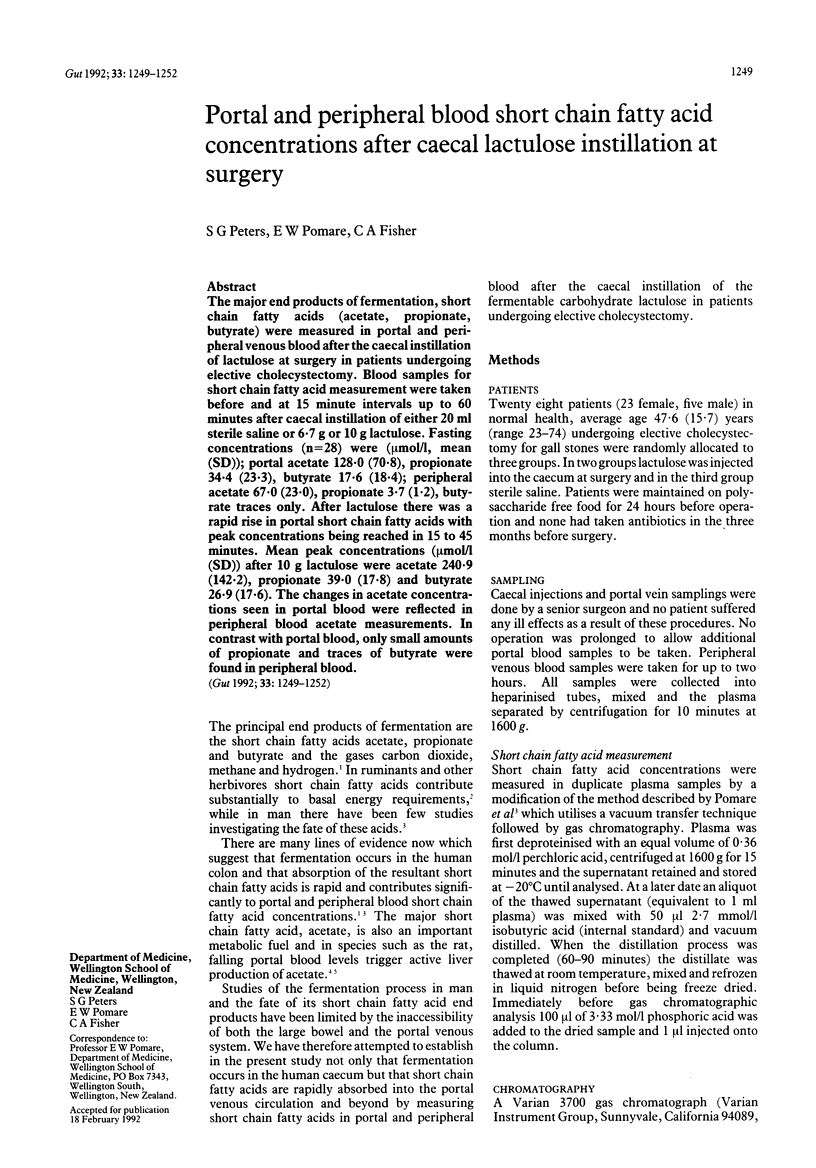Abstract
The major end products of fermentation, short chain fatty acids (acetate, propionate, butyrate) were measured in portal and peripheral venous blood after the caecal instillation of lactulose at surgery in patients undergoing elective cholecystectomy. Blood samples for short chain fatty acid measurement were taken before and at 15 minute intervals up to 60 minutes after caecal instillation of either 20 ml sterile saline or 6.7 g or 10 g lactulose. Fasting concentrations (n = 28) were (mumol/l, mean (SD)); portal acetate 128.0 (70.8), propionate 34.4 (23.3), butyrate 17.6 (18.4); peripheral acetate 67.0 (23.0), propionate 3.7 (1.2), butyrate traces only. After lactulose there was a rapid rise in portal short chain fatty acids with peak concentrations being reached in 15 to 45 minutes. Mean peak concentrations (mumol/l (SD)) after 10 g lactulose were acetate 240.9 (142.2), propionate 39.0 (17.8) and butyrate 26.9 (17.6). The changes in acetate concentrations seen in portal blood were reflected in peripheral blood acetate measurements. In contrast with portal blood, only small amounts of propionate and traces of butyrate were found in peripheral blood.
Full text
PDF



Selected References
These references are in PubMed. This may not be the complete list of references from this article.
- ANNISON E. F., WHITE R. R. Further studies on the entry rates of acetate and glucose in sheep, with special reference to endogenous production of acetate. Biochem J. 1962 Sep;84:546–552. doi: 10.1042/bj0840546. [DOI] [PMC free article] [PubMed] [Google Scholar]
- Ballard F. J. Supply and utilization of acetate in mammals. Am J Clin Nutr. 1972 Aug;25(8):773–779. doi: 10.1093/ajcn/25.8.773. [DOI] [PubMed] [Google Scholar]
- Buckley B. M., Williamson D. H. Origins of blood acetate in the rat. Biochem J. 1977 Sep 15;166(3):539–545. doi: 10.1042/bj1660539. [DOI] [PMC free article] [PubMed] [Google Scholar]
- Cummings J. H., Englyst H. N. Fermentation in the human large intestine and the available substrates. Am J Clin Nutr. 1987 May;45(5 Suppl):1243–1255. doi: 10.1093/ajcn/45.5.1243. [DOI] [PubMed] [Google Scholar]
- Cummings J. H. Fermentation in the human large intestine: evidence and implications for health. Lancet. 1983 May 28;1(8335):1206–1209. doi: 10.1016/s0140-6736(83)92478-9. [DOI] [PubMed] [Google Scholar]
- Cummings J. H., Pomare E. W., Branch W. J., Naylor C. P., Macfarlane G. T. Short chain fatty acids in human large intestine, portal, hepatic and venous blood. Gut. 1987 Oct;28(10):1221–1227. doi: 10.1136/gut.28.10.1221. [DOI] [PMC free article] [PubMed] [Google Scholar]
- Hoskins L. C., Boulding E. T. Mucin degradation in human colon ecosystems. Evidence for the existence and role of bacterial subpopulations producing glycosidases as extracellular enzymes. J Clin Invest. 1981 Jan;67(1):163–172. doi: 10.1172/JCI110009. [DOI] [PMC free article] [PubMed] [Google Scholar]
- Hoskins L. C. Human enteric population ecology and degradation of gut mucins. Dig Dis Sci. 1981 Sep;26(9):769–772. doi: 10.1007/BF01309606. [DOI] [PubMed] [Google Scholar]
- Keys J. E., Jr, DeBarthe J. V. Cellulose and hemicellulose digestibility in the stomach, small intestine and large intestine of swine. J Anim Sci. 1974 Jul;39(1):53–56. doi: 10.2527/jas1974.39153x. [DOI] [PubMed] [Google Scholar]
- Knowles S. E., Jarrett I. G., Filsell O. H., Ballard F. J. Production and utilization of acetate in mammals. Biochem J. 1974 Aug;142(2):401–411. doi: 10.1042/bj1420401. [DOI] [PMC free article] [PubMed] [Google Scholar]
- LINDENEG O., MELLEMGAARD K., FABRICIUS J., LUNDQUIST F. MYOCARDIAL UTILIZATION OF ACETATE, LACTATE AND FREE FATTY ACIDS AFTER INGESTION OF ETHANOL. Clin Sci. 1964 Dec;27:427–435. [PubMed] [Google Scholar]
- Lundquist F., Sestoft L., Damgaard S. E., Clausen J. P., Trap-Jensen J. Utilization of acetate in the human forearm during exercise after ethanol ingestion. J Clin Invest. 1973 Dec;52(12):3231–3235. doi: 10.1172/JCI107523. [DOI] [PMC free article] [PubMed] [Google Scholar]
- Perman J. A., Modler S. Glycoproteins as substrates for production of hydrogen and methane by colonic bacterial flora. Gastroenterology. 1982 Aug;83(2):388–393. [PubMed] [Google Scholar]
- Pethick D. W., Lindsay D. B., Barker P. J., Northrop A. J. Acetate supply and utilization by the tissues of sheep in vivo. Br J Nutr. 1981 Jul;46(1):97–110. doi: 10.1079/bjn19810013. [DOI] [PubMed] [Google Scholar]
- Pomare E. W., Branch W. J., Cummings J. H. Carbohydrate fermentation in the human colon and its relation to acetate concentrations in venous blood. J Clin Invest. 1985 May;75(5):1448–1454. doi: 10.1172/JCI111847. [DOI] [PMC free article] [PubMed] [Google Scholar]
- Rémésy C., Demigné C. Changes in availability of glucogenic and ketogenic substrates and liver metabolism in fed or starved rats. Ann Nutr Metab. 1983;27(1):57–70. doi: 10.1159/000176624. [DOI] [PubMed] [Google Scholar]
- Rémésy C., Demigné C., Chartier F. Origin and utilization of volatile fatty acids in the rat. Reprod Nutr Dev. 1980;20(4B):1339–1349. doi: 10.1051/rnd:19800725. [DOI] [PubMed] [Google Scholar]
- Salyers A. A., West S. E., Vercellotti J. R., Wilkins T. D. Fermentation of mucins and plant polysaccharides by anaerobic bacteria from the human colon. Appl Environ Microbiol. 1977 Nov;34(5):529–533. doi: 10.1128/aem.34.5.529-533.1977. [DOI] [PMC free article] [PubMed] [Google Scholar]
- Saunders D. R., Wiggins H. S. Conservation of mannitol, lactulose, and raffinose by the human colon. Am J Physiol. 1981 Nov;241(5):G397–G402. doi: 10.1152/ajpgi.1981.241.5.G397. [DOI] [PubMed] [Google Scholar]
- Seufert C. D., Mewes W., Soeling H. D. Effect of long-term starvation on acetate and ketone body metabolism in obese patients. Eur J Clin Invest. 1984 Apr;14(2):163–170. doi: 10.1111/j.1365-2362.1984.tb02107.x. [DOI] [PubMed] [Google Scholar]
- Skutches C. L., Holroyde C. P., Myers R. N., Paul P., Reichard G. A. Plasma acetate turnover and oxidation. J Clin Invest. 1979 Sep;64(3):708–713. doi: 10.1172/JCI109513. [DOI] [PMC free article] [PubMed] [Google Scholar]
- Snoswell A. M., Trimble R. P., Fishlock R. C., Storer G. B., Topping D. L. Metabolic effects of acetate in perfused rat liver. Studies on ketogenesis, glucose output, lactate uptake and lipogenesis. Biochim Biophys Acta. 1982 Jun 16;716(3):290–297. doi: 10.1016/0304-4165(82)90019-8. [DOI] [PubMed] [Google Scholar]
- Tollinger C. D., Vreman H. J., Weiner M. W. Measurement of acetate in human blood by gas chromatography: effects of sample preparation, feeding, and various diseases. Clin Chem. 1979 Oct;25(10):1787–1790. [PubMed] [Google Scholar]
- Vercellotti J. R., Salyers A. A., Bullard W. S., Wilkins D. Breakdown of mucin and plant polysaccharides in the human colon. Can J Biochem. 1977 Nov;55(11):1190–1196. doi: 10.1139/o77-178. [DOI] [PubMed] [Google Scholar]


